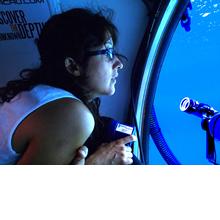Is increasing artificial light at night a danger to coral reefs?
.jpg_SIA_JPG_fit_to_width_INLINE.jpg)
The potentially damaging effects of manmade light at night on the reproduction of reef corals is the subject of new research involving Ocean and Earth Science researchers from the University of Southampton.
Thanks to funding from a Natural Environment Research Council (NERC) Highlight Grant in the UK, Southampton Professor Jörg Wiedenmann and Dr Cecilia D’Angelo from the University’s Coral Reef Laboratory will tackle gaps in our understanding as to how the reproduction of reef corals is affected by artificial light at night (ALAN). In this research, they will work together with a team of researchers from Bangor University and other UK Universities, the Interuniversity of Marine Science Eilat and Bar Ilan University (Israel) and the Horniman Museum London.
“Coral reefs are immensely valuable ecosystems” explains Professor Wiedenmann, “but they are in serious decline due to global warming and local anthropogenic impacts such as coastal construction, overfishing, pollution and nutrient enrichment.” He continues: “Key to coral reef survival is that the remaining individuals produce enough offspring that can recruit on damaged reefs and help them to recover.”
To maximise reproductive success, many corals release their eggs and sperm at the same time, sometimes in only a single night of the year in a process called mass coral spawning. The timing of mass coral spawning is thought to be synchronised and triggered by the light of the moon. The scientists fear that the increasing amounts of artificial light at night may override the signal of the moonlight, resulting in a less efficient synchronisation of the coral reproduction and reduced recruitment of juvenile corals on reefs.
Artificial ‘sky glow’ can now be detected above 22% of the world’s coasts nightly. That figure is expected to increase dramatically as coastal human populations more than double by 2060.
Many coastlines are exposed to artificial light at night by piers, promenades, ports, harbours and dockyards, increasingly with white LED lighting (Light Emitting Diodes) which can penetrate deeper into seawater than older lighting technologies and many marine organism responses are most sensitive to.
Unsurprisingly, LED lighting is predicted to represent 69% of global lighting by 2020, further exacerbating the impacts of artificial light at night.
The coral research at Southampton is part of a larger project led by the University of Bangor that studies the impact of artificial light at night on marine life.
“The presence of artificial light in coastal regions has the potential to interfere with natural light cycles and the biological processes they inform, ultimately reshaping the ecology of coastal habitats,” says Professor Wiedenmann. “We know that many marine invertebrates are extremely sensitive to natural light throughout their life cycle and that that gradients of light intensity and colour, largely caused by variations in moon- and sunlight, is a major structuring factor in marine ecosystems
“We now need to make further inroads into how much damage is caused by artificial light and help to quantify the benefits of diminishing intense forms of artificial light on various species and their interactions with each other. This will be vital to the future of our coastal habitats around the world,” Professor Wiedenmann continued, “The Coral Reef Laboratory in Southampton is well-known for leading research in coral physiology and our collaboration with a wide network of excellent scientists provides the best possible conditions for a successful realisation of the proposed research under this project.”

